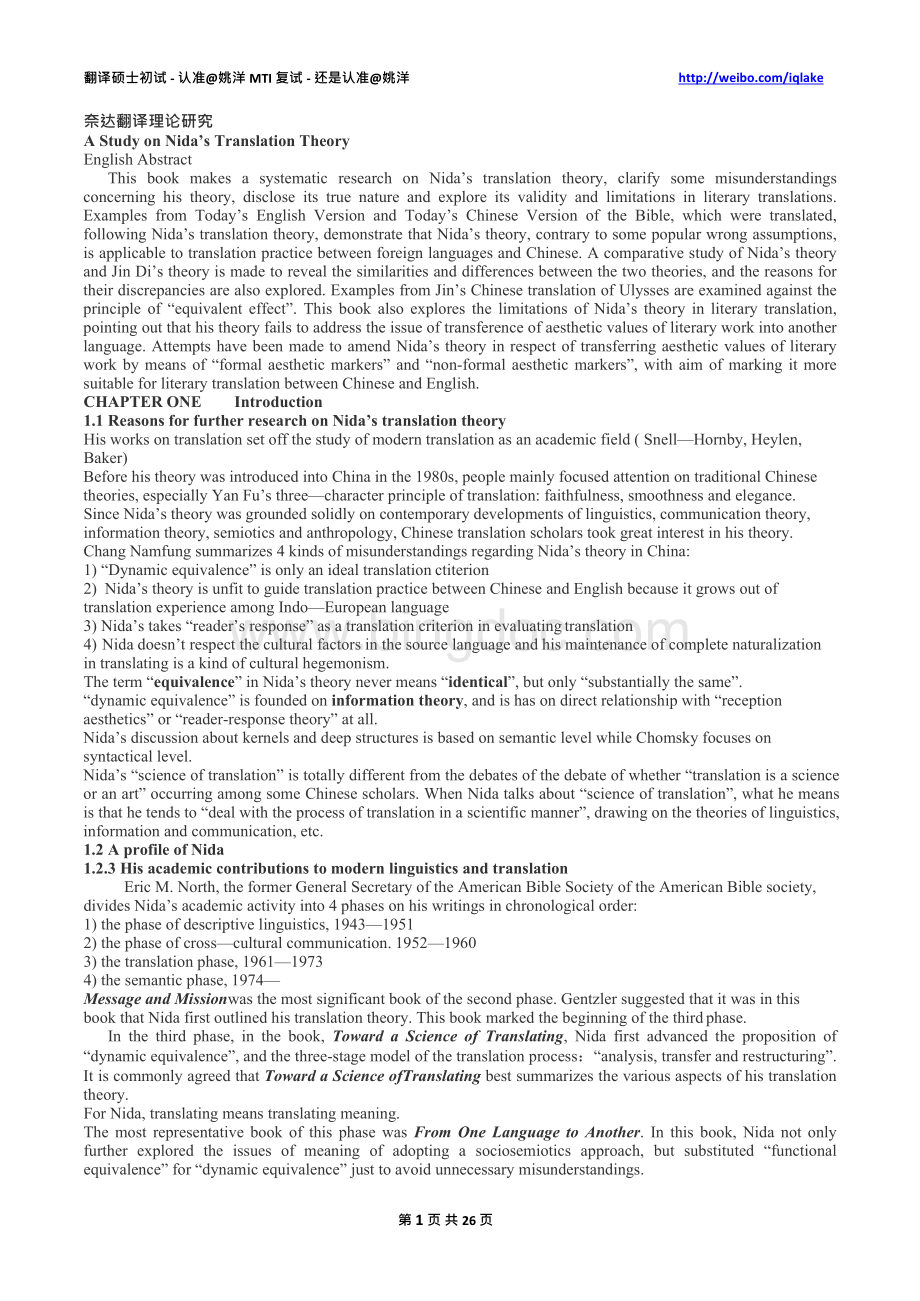奈达翻译理论研究英文笔记.docx
《奈达翻译理论研究英文笔记.docx》由会员分享,可在线阅读,更多相关《奈达翻译理论研究英文笔记.docx(26页珍藏版)》请在冰点文库上搜索。

翻译硕士初试-认准@姚洋MTI复试-还是认准@姚洋
奈达翻译理论研究
AStudyonNida’sTranslationTheory
EnglishAbstract
ThisbookmakesasystematicresearchonNida’stranslationtheory,clarifysomemisunderstandingsconcerninghistheory,discloseitstruenatureandexploreitsvalidityandlimitationsinliterarytranslations.ExamplesfromToday’sEnglishVersionandToday’sChineseVersionoftheBible,whichweretranslated,followingNida’stranslationtheory,demonstratethatNida’stheory,contrarytosomepopularwrongassumptions,isapplicabletotranslationpracticebetweenforeignlanguagesandChinese.AcomparativestudyofNida’stheoryandJinDi’stheoryismadetorevealthesimilaritiesanddifferencesbetweenthetwotheories,andthereasonsfortheirdiscrepanciesarealsoexplored.ExamplesfromJin’sChinesetranslationofUlyssesareexaminedagainsttheprincipleof“equivalenteffect”.ThisbookalsoexploresthelimitationsofNida’stheoryinliterarytranslation,pointingoutthathistheoryfailstoaddresstheissueoftransferenceofaestheticvaluesofliteraryworkintoanotherlanguage.AttemptshavebeenmadetoamendNida’stheoryinrespectoftransferringaestheticvaluesofliteraryworkbymeansof“formalaestheticmarkers”and“non-formalaestheticmarkers”,withaimofmarkingitmoresuitableforliterarytranslationbetweenChineseandEnglish.
CHAPTERONE Introduction
1.1ReasonsforfurtherresearchonNida’stranslationtheory
Hisworksontranslationsetoffthestudyofmoderntranslationasanacademicfield(Snell—Hornby,Heylen,Baker)
BeforehistheorywasintroducedintoChinainthe1980s,peoplemainlyfocusedattentionontraditionalChinesetheories,especiallyYanFu’sthree—characterprincipleoftranslation:
faithfulness,smoothnessandelegance.
SinceNida’stheorywasgroundedsolidlyoncontemporarydevelopmentsoflinguistics,communicationtheory,informationtheory,semioticsandanthropology,Chinesetranslationscholarstookgreatinterestinhistheory.
ChangNamfungsummarizes4kindsofmisunderstandingsregardingNida’stheoryinChina:
1)“Dynamicequivalence”isonlyanidealtranslationctiterion
2)Nida’stheoryisunfittoguidetranslationpracticebetweenChineseandEnglishbecauseitgrowsoutoftranslationexperienceamongIndo—Europeanlanguage
3)Nida’stakes“reader’sresponse”asatranslationcriterioninevaluatingtranslation
4)Nidadoesn’trespecttheculturalfactorsinthesourcelanguageandhismaintenanceofcompletenaturalizationintranslatingisakindofculturalhegemonism.
Theterm“equivalence”inNida’stheorynevermeans“identical”,butonly“substantiallythesame”.
“dynamicequivalence”isfoundedoninformationtheory,andishasondirectrelationshipwith“receptionaesthetics”or“reader-responsetheory”atall.
Nida’sdiscussionaboutkernelsanddeepstructuresisbasedonsemanticlevelwhileChomskyfocusesonsyntacticallevel.
Nida’s“scienceoftranslation”istotallydifferentfromthedebatesofthedebateofwhether“translationisascienceoranart”occurringamongsomeChinesescholars.WhenNidatalksabout“scienceoftranslation”,whathemeansisthathetendsto“dealwiththeprocessoftranslationinascientificmanner”,drawingonthetheoriesoflinguistics,informationandcommunication,etc.
1.2AprofileofNida
1.2.3Hisacademiccontributionstomodernlinguisticsandtranslation
EricM.North,theformerGeneralSecretaryoftheAmericanBibleSocietyoftheAmericanBiblesociety,dividesNida’sacademicactivityinto4phasesonhiswritingsinchronologicalorder:
1)thephaseofdescriptivelinguistics,1943—1951
2)thephaseofcross—culturalcommunication.1952—1960
3)thetranslationphase,1961—1973
4)thesemanticphase,1974—
MessageandMissionwasthemostsignificantbookofthesecondphase.GentzlersuggestedthatitwasinthisbookthatNidafirstoutlinedhistranslationtheory.Thisbookmarkedthebeginningofthethirdphase.
Inthethirdphase,inthebook,TowardaScienceofTranslating,Nidafirstadvancedthepropositionof“dynamicequivalence”,andthethree-stagemodelofthetranslationprocess:
“analysis,transferandrestructuring”.ItiscommonlyagreedthatTowardaScienceofTranslatingbestsummarizesthevariousaspectsofhistranslationtheory.
ForNida,translatingmeanstranslatingmeaning.
ThemostrepresentativebookofthisphasewasFromOneLanguagetoAnother.Inthisbook,Nidanotonlyfurtherexploredtheissuesofmeaningofadoptingasociosemioticsapproach,butsubstituted“functionalequivalence”for“dynamicequivalence”justtoavoidunnecessarymisunderstandings.
第9页共26页
1.3AsurveyofNida’stranslationtheory
WewillreviewNida’stranslationtheoryfromtwoimportantaspects:
1)thescientificstudyoftranslating
2)theprincipleof“dynamicequivalence”
1.3.1Nida’sscientificstudyoftranslating
“Scienceoftranslating”means“forjustaslinguisticsmaybeclassifiedasadescriptivescience,sothetransferenceofamessagefromonelanguagetoanotherislikewiseavalidsubjectforscientificdescription.Hesuggeststhatitismoreeffectivetotransferthemeaningfromthesourcelanguagetothereceptorlanguageonthekernellever,becauseonthisleverthelinguisticmeaningoftheoriginaltestisstructurallythesimplestandsemanticallymostevident.
Nidaadvancesathree-steptranslationprocess:
1toanalyzesource-languageexpressionsintermsofbasickernelsentences2totransformthekernelformsofthesourcelanguageintotheequivalentkernelformsofthereceptorlanguage3totransformthekernelutterancesofthereceptorlanguageintothestylisticallyappropriateexpression
Thisprocessoftranslatinghelpsthetranslatorconsciouslyavoidliteraltranslation.
Theprincipleof“dynamicequivalence”(whichwaslatermodifiedinto“functionalequivalence”)hasascientificbasisaswell.Itissolidly foundedoninformationtheoryorcommunicationtheory.
Nidaseestranslationasacommunicationevent.
Nidaholdsthatintranslating,thefirstthingoneshoulddoistounderstandthoroughlythemeaningofthesourcetext.Inadequateunderstandingoftheoriginaltextisthemajorcauseforfailuresintranslation.Indescribingreferentialmeaningofwordsorphrases,heusesvarioustechniquesofsemantictheoriessuchaschainanalysis,hierarchicalanalysisandcomponentialanalysis.
ItisevidentthatNida’stheoryoftranslationisnotmerelylinguistic—oriented,butsociolinguistic—oriented.
1.3.2Theprincipleofdynamicequivalence
Translatingconsistsinproducinginthereceptorlanguagetheclosetnaturalequivalenttothemessageofthesourcelanguage,firstinmeaningandsecondlyinstyle.
Inhis1969textbookTheTheoryandPracticeofTranslation,“dynamicequivalence”isdefined“intermsofthedegreetowhichthereceptorsofthemessageinthereceptorlanguagerespondtoitinsubstantiallythesamemannerasthereceptorsinthesourcelanguage”.
InFromOneLanguagetoAnother,theexpression“dynamicequivalence”issupersededby“functionalequivalence”.Thesubstitutionof“functionalequivalence”isjusttostresstheconceptoffunctionandtoavoidmisunderstandingsoftheterm“dynamic”.
InLanguage,CultureandTranslation,“functionalequivalence”isfurtherdividedintocategoriesontwolevels:
theminimallevelandthemaximallevel.Theminimallevelisdefinedas“thereadersofatranslatedtextshouldbeabletocomprehendintothepointthattheycanconceiveofhowtheoriginalreadersofthetextmusthaveunderstoodandappreciatedit”. Themaximallevelisstatedas“theessentiallythesamemannerastheoriginalreadersdid”.
InNida’stheory,“dynamicequivalence”isdefinedwith“receptors’response”asitsnature.Nida’sconceptoftranslatingshiftsfrom“theformofmessage”to“theresponseofthereceptor”.
InNida’sview,whendeterminingwhetheratranslationisfaithfultotheoriginaltextornot,thecriticshouldnotcomparetheformalstructuresbetweenthesourcetextanditstranslation,butcomparethe“receptors’response”. Ifhefindsthatthethereaderinthereceptorlanguageunderstandsandappreciatesthetranslatedtextinessentiallythesamemannerandtothesamedegreeasthereaderinthesourcelanguagedid,suchatranslationcanbeevaluatedasadynamicequivalenttranslation.
Nida’stheoryof“readers’response”emphasizestheimportanceoftheacceptanceofatranslatedtextbytheintendedreaderinthereceptorlanguage,andavoidsthesubjectiveevaluationofthecritic.
Nida’stheoryhaspracticalsignificanceforliterarytranslationinsomeaspects,butitisafactthatitfailstoaddresstheissueoftransferringaestheticvaluesofliteraryworkinliterarytranslation.
TheinadequacyofNida’stheoryforliterarytranslationismademanifestin3aspects:
1Nidapayslittleattentiontothetransferenceofstyleinhistranslationprocess:
2Nida’sdiscussionofstyleisverygeneralandsuperficial:
3Nida’sfunctionalapproachtostyledoesnotprovideeffectivemeanstotransferaestheticvaluesofliterarywork.
1.4Theguidingprinciplesoftheresearch
Thetaskoftranslationtheoryistostudytranslationproblems,notranslationproblems,notranslationtheory(Newmark1998).
1.5Themethodologicalapproach
Differentviewsoftranslationaredeterminedbydifferentviewsoflanguageandculture.
InNida’sview,eachlanguagehasitsowngenius,andtherearenosuchthingsassuperiororinferiorlanguages.Anythingthatcanbesaidinonelanguagecanbesaidinanother,andhumanlanguageshavemoreincommonthanindifference.Itisthisviewoflanguagethatprovidesthetheoreticalba